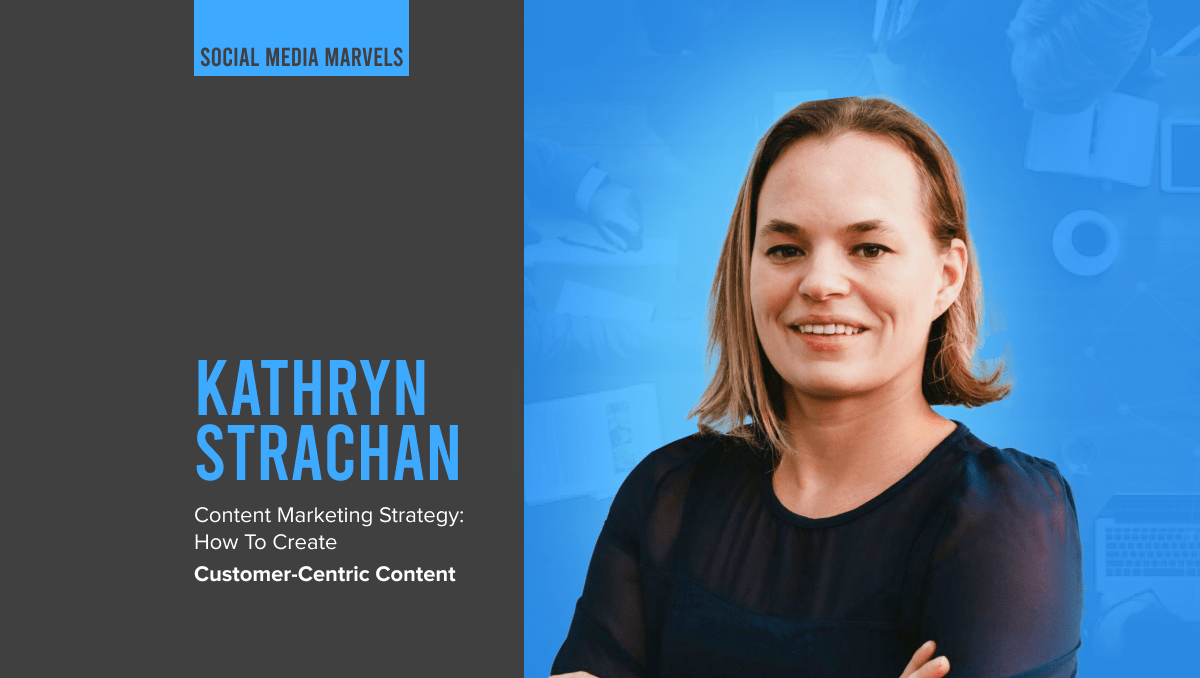Kathryn Strachan is the Head of Content at CopyHouse—a content marketing agency that specializes primarily in writing long-form and SEO copy for FinTech and financial services companies.
In a talk with Jagruti Bhargav of SocialPilot, Kathryn spoke about how CopyHouse is all about words and writes every kind of copy found online, whether it is whitepapers, blog posts, landing pages, or email campaigns.
What do I learn from the video :
- Identifying the right audience for your business
- Adding value through your content
- Building a content strategy by setting an ideal customer persona
Q: You write landing page copies and run nurture campaigns, meaning you really need to understand the audience that your client is dealing with. Where do you think one should ideally start their customer persona research? Should they go to the market or ask the experts or do an in-depth competitor analysis?
A: From the second you become a brand, you should be thinking about who your target customers are. When I ask my clients these questions, they often tell me about the people that they are currently working with. But what I am interested in knowing is who you want to work with. Customer persona research comes way before competitor analysis because who you are working with and who you want to work with is going to define who your competitors are.
So before you really dive into market research or what your target audience thinks, wants and needs, you need to create at least a rough idea of who you want to work with. It comes from your own desires and interests, in that the people that you really connect with and want to serve and work with.
You need to ask yourself certain questions from the top level stuff to the really basic but important things like:
- What does your ideal customer look like?
- Who are your clients?
- What kind of role do they work in?
- Where do they live?
- How much money do they make or earn or spend?
- What are their most pressing needs, desires, wants, and wishes?
Once you understand this information, you can position your product or service to meet those needs and desires. Without that fundamental information, it’s almost impossible.
Q: How important is building content around the pain points of the people you want to work with?
A: Somebody once said, “When you try to speak to everybody, you end up speaking to no one.”
When you don’t understand who you are talking to, you send out content that’s really generic; that falls on deaf ears because nobody can relate to it. But when you know who you are talking to, you can make them sit up and say, “Yes, I get it.” These people understand that your brand is going to change their life. So everything that you write, be it your website content or blog posts, should be perfectly attuned to who you want to work with such that it makes them feel like you’re speaking to them.
Q: We have often heard that we should create humanized content because at the end of the day wherever the content is shared, it’s going to be looked at from a human perspective by a human being. So how can a business add a personality to their content?
A: You see this quite a lot as the difference between B2B and B2C content. B2B writers and marketers sometimes forget that who they’re speaking to are humans. So I might be a human in a job in an organization, but I am still a human. At the end of the day, humans, whether they are at work or at play, have needs, desires, wishes and pain points. And it’s that pain point that is causing hassle in their life, or wasting their time, or making it harder for them to do their job or enjoy the high life or relax. Now, identifying that pain point takes your service from being a vitamin and nice to have ‘I can buy it tomorrow; I don’t really need it today’ to a headache reliever where they’re going to buy it right there and actually press ‘Purchase’.
Q: You mentioned that talking about the pain points and pressing needs of people makes them want to press the Purchase button instead of deferring their decision. Also, the audience can discover you from various avenues, right? So should a content piece be re-purposed in a form that the audience can discover it better?
A: Yeah! When you write an article or a blog post, one of the worst things you can probably do is just leave it on your website. You need to take that blog post and deliver it to your people, whether that involves sharing it across social media or via newsletter, or doing some outreaching and getting it out as a guest post. You need to disseminate your content for people to consume it. Otherwise, even if it is SEO-optimized, it’s not going to achieve the best results, though it might get on the first page of search results in a rare case.
Therefore, I always encourage my clients to think about a piece of content as part of a wider strategy. We are not only doing a piece of content, but also social posts and emails. We put all these things together to get the best results.
You need to remember that the social media platform that you use, or the newsletter that you create or the guest post that you write or share should be lined up with your target audience. For example, if you are a B2B brand and work for accountants, one of the best places to reach accountants could be LinkedIn. However, if you are a lifestyle and travel brand, the best platform to reach your target audience might be Instagram or Facebook.
Think about who you are trying to reach, how they spend time online, what other blogs they read, what new sources they are spending their time looking at. Then, you can use these channels that they’re already engaging with and get your blog in front of them. For example, if they are already reading the International Accounting Association Journal or something similar, getting your blog post on that platform will allow them to see and understand your brand through their already trusted platform.
The same goes with social media. People are already logging in to Instagram to scroll through their feeds every day. So you can easily make them discover your brand. It’s a more natural way for them to connect with your brand. I read a LinkedIn post the other day that said that people aren’t logging in to your company’s website to scroll through every single day, but they do wake up and go straight to their Facebook or Instagram or Twitter feeds and scroll through that every single day. So being on the platforms where they are already engaging makes them establish a relationship with you.
Q: I read somewhere that on average, a human spends nine hours of his day on social media. A brand would, of course, want to leverage this time to grab people’s attention. Could you share certain actionable strategies that would encourage the audience to hit the Purchase button while they scroll through social media?
A: Start by asking yourself some very specific questions.
- Who are your ideal customers?
Remember that these aren’t your current customers. They are the people that you want to work with. Imagine who you would choose if you could work with anybody in the entire world. Then, ask:
- What do they care about?
- What are their values?
- What do they think about?
- What’s their biggest pain point?
- What is a thing in their lives that’s causing them the most hassle or inconvenience?
- How can you position your product or service to make their lives easier or better?
Alongside, you should also ask questions like:
- Where do these people spend their time online?
- What kind of content do they already consume?
- Who do they follow?
All this information will help shape your overall content strategy.
At this point, you are working on your current understanding, maybe with people who have said things like, “Oh! I already love to work with you.” But perhaps, you haven’t done any in-depth research yet.
Therefore, the next step is to go and talk to the people who fit your ideal customer avatar.
You might already have the right clients that fit your ideal customer profile. But if you need to go and find some, ask yourself the aforementioned questions and see if your insights and understanding of your target customer is correct. You might discover something new, for instance, you might think that they read a certain blog every day but they actually are spending their time online elsewhere.
The information that comes from asking the recommended questions validates, confirms or dismisses the insights that you made earlier. You may also generate some leads during the process as you might speak to somebody who you have a fantastic conversation with, which goes, “Oh! I could really use your services.”
Regardless, after getting the answers to your questions, you need to start implementing the insights across your content marketing strategy. They are going to influence things such as the type of content you create, whether that’s a thought leadership video or a podcast, and how you show that content. Also, it will influence where you post your content online, whether that’s Medium, LinkedIn Articles, or social media platforms, and at what time you share your content.
Here at CopyHouse, we use this process with all of our clients. We always start conversations (whether you are a potential client, a lead, or a current client) with understanding of the ideal customer. Some of our clients try to reach us only after spending time thinking about and answering these questions. Others start from the ground up.
Concerning the clients who haven’t started this process, we walk them through the step and help them conduct the market research by carrying out interviews, asking questions, and talking to their ideal customers, either online or via the phone. Once we have the insights, we use them to shape our content marketing strategy. It influences everything, such as our recommendations, whether we recommend that you use LinkedIn or send your content via newsletter or focus your efforts on Instagram and Facebook. All of our recommendations are founded on our understanding of who your ideal customer is.
This is why my biggest recommendation to a content marketer or anybody who wants to create effective and engaging content is to think about their ideal customer and really nail it down.
Get your customer profiles in shape before you do anything else. Understand why you started the company in the first place before starting to identify who you should deal with.
The #SocialMediaMarvels is a podcast series that invites digital marketing influencers from across the world to celebrate their journey and get a glimpse of their contributions to the field. Get actionable tips, learn directly from the practitioners, and imbibe it to help your business.

